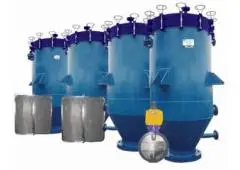Optimizing Filtration Efficiency: Vertical and Horizontal Pressure Leaf Filters
Description
In industrial processes where the removal of fine solid particles and impurities from liquids is paramount, pressure leaf filters emerge as reliable and efficient filtration solutions. Among these, both vertical and horizontal pressure leaf filters play pivotal roles in various applications. Let's explore the features, functionalities, and applications of these two filtration systems:
Vertical Pressure Leaf Filter:
Features:
Vertical Configuration: Vertical pressure leaf filters have a vertically arranged assembly of filter elements within a cylindrical vessel. This design optimizes space utilization and facilitates efficient filtration under gravity or pressure-driven flow conditions.
Filter Media: These filters employ filter leaves or plates made of porous materials such as cloth, wire mesh, or metal screens. These filter elements capture solid particles while allowing the filtered liquid to pass through.
Cake Discharge Mechanism: Vertical pressure leaf filters typically incorporate a hydraulic or pneumatic cake discharge mechanism. This mechanism facilitates the removal of filtered solids from the filter elements, ensuring continuous operation with minimal downtime.
Applications:
- Vertical pressure leaf filters find applications in various industries, including edible oil refining, chemical processing, pharmaceutical production, and beverage manufacturing. They are used for the filtration of liquids containing solid impurities, such as catalysts, intermediates, juices, and process streams.
Horizontal Pressure Leaf Filter:
Features:
Horizontal Orientation: Horizontal pressure leaf filters have a horizontally arranged assembly of filter elements within a cylindrical or rectangular vessel. This design may be preferred in applications where space constraints or process layout dictate a horizontal configuration.
Filter Media: Similar to vertical pressure leaf filters, horizontal filters use filter leaves or plates made of porous materials. These filter elements capture solid particles while allowing the filtered liquid to pass through.
Cake Discharge Mechanism: Horizontal pressure leaf filters also incorporate a cake discharge mechanism, typically hydraulic or pneumatic. This mechanism facilitates the removal of filtered solids from the filter elements, ensuring continuous operation.
Applications:
- Horizontal pressure leaf filters are used in industries such as oil refining, chemical processing, and pharmaceutical production. They are suitable for applications requiring high filtration efficiency and continuous operation, such as the removal of catalyst fines, activated carbon, or solid impurities from process streams.
Comparison:
Orientation: The primary difference between vertical and horizontal pressure leaf filters lies in their orientation. Vertical filters have a vertical arrangement of filter elements, while horizontal filters have a horizontal arrangement.
Space Utilization: Vertical pressure leaf filters optimize vertical space utilization, making them suitable for applications with limited floor space. Horizontal filters may be preferred in installations where horizontal space is more abundant.
Cake Discharge: Both types of filters employ cake discharge mechanisms to remove filtered solids. However, the orientation of the filter elements may influence the design and operation of the cake discharge mechanism.
Conclusion:
In conclusion, both vertical and horizontal pressure leaf filters are valuable tools for liquid-solid separation in industrial processes. Whether in edible oil refining, chemical processing, pharmaceutical production, or beverage manufacturing, these filtration systems offer efficient and reliable solutions for removing solid impurities from liquids. The choice between vertical and horizontal configurations depends on factors such as space constraints, process requirements, and installation preferences. Ultimately, both types of pressure leaf filters contribute to improved process efficiency, product quality, and operational reliability across diverse industrial applications.






Useful information
- Avoid scams by acting locally or paying with PayPal
- Never pay with Western Union, Moneygram or other anonymous payment services
- Don't buy or sell outside of your country. Don't accept cashier cheques from outside your country
- This site is never involved in any transaction, and does not handle payments, shipping, guarantee transactions, provide escrow services, or offer "buyer protection" or "seller certification"






